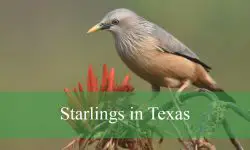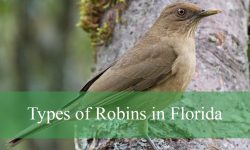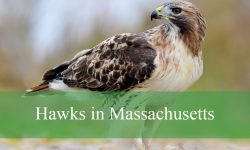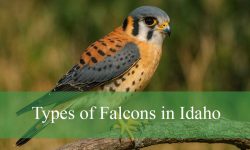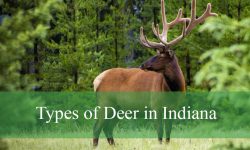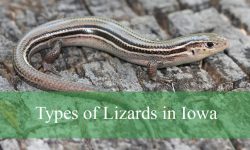Backyard Birds in Indiana bring color and life to gardens, parks, and neighborhoods throughout the year. From bright cardinals to cheerful sparrows, these birds are easy to spot and enjoy for both beginners and experienced birdwatchers. Watching birds in your own backyard is a great way to connect with nature and learn about local wildlife.
Indiana’s diverse habitats attract many different species of backyard birds. Whether you live in the city, suburbs, or rural areas, you can find a variety of birds visiting feeders, nesting in trees, or foraging on the ground. Each bird has unique features and behaviors that make them interesting to identify and observe.
In this guide, we introduce 35 common backyard birds in Indiana, complete with pictures and identification tips. This will help you recognize and appreciate the feathered friends that visit your outdoor spaces, making birdwatching fun and rewarding all year long.
Common Backyard Birds Found in Indiana
Baltimore Oriole
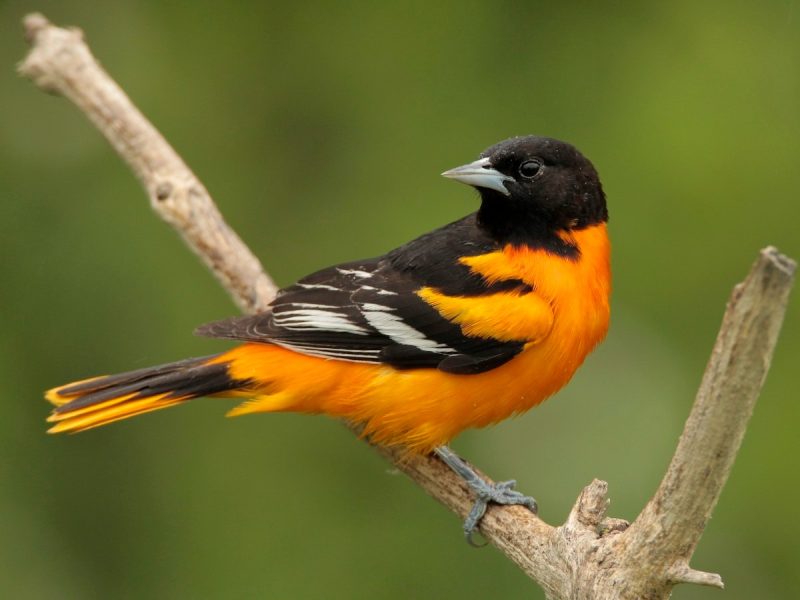
The Baltimore Oriole is a medium-sized songbird known for its brilliant orange and black plumage, especially vivid in males during the breeding season. Females and immature birds display a more muted yellow-orange coloration with grayish wings. Orioles measure about 7 to 8 inches in length and have slender bodies with sharp bills adapted for feeding on nectar and insects.
These birds prefer open woodlands, edges, and suburban parks with tall trees, where they often hang their distinctive, pouch-like woven nests from branches. Baltimore Orioles feed on nectar, fruit, and insects, and they are frequent visitors to feeders offering orange slices, grape jelly, and specialized nectar feeders.
In Indiana, Baltimore Orioles arrive in spring for breeding and can be seen throughout summer. Their brilliant coloration and melodic songs make them a favorite among bird watchers. Their preference for tall trees and willingness to visit feeders bring a splash of bright color to many Indiana backyards during warmer months.
Northern Cardinal
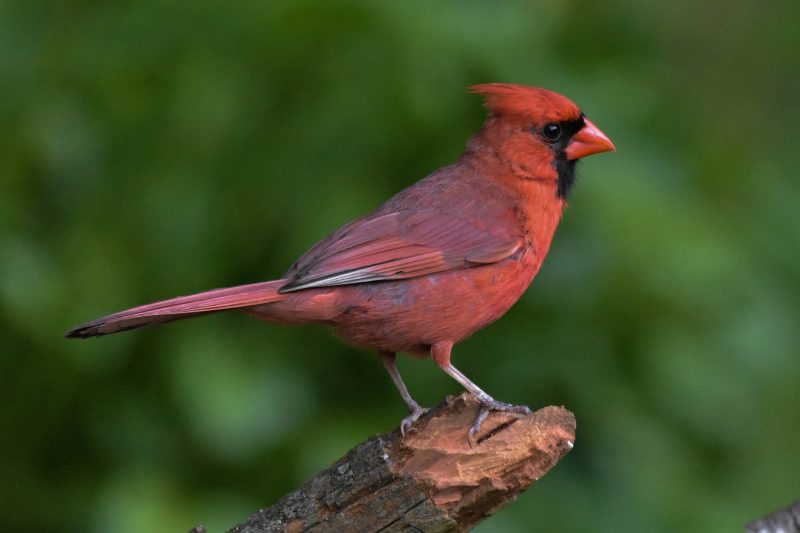
The Northern Cardinal is a strikingly bright bird, with males showing a vibrant red plumage all over their body, accented by a black mask around the face. Females, on the other hand, have a more subdued coloration, featuring warm brown feathers with reddish tinges on the wings, tail, and crest. Cardinals are medium-sized songbirds, about 8 to 9 inches long, with a distinctive crest on the head and a strong, conical orange-red beak.
Cardinals are easy to identify in the backyard due to their bright colors and unique shape. Males are especially eye-catching with their brilliant red bodies, while females blend well in wooded areas with their more muted colors. Both sexes have a crest that rises when excited or alert, and their clear, whistling songs are common sounds in Indiana’s backyards from spring through fall.
In Indiana, Northern Cardinals are year-round residents, favoring shrubbery, thickets, and wood edges near residential areas. They are frequent visitors to backyard feeders, especially enjoying sunflower seeds, safflower seeds, and cracked corn. Cardinals are territorial birds, often seen defending their feeding spots and singing to mark their territory. Their presence is a delight for bird watchers across Indiana throughout the year.
American Robin
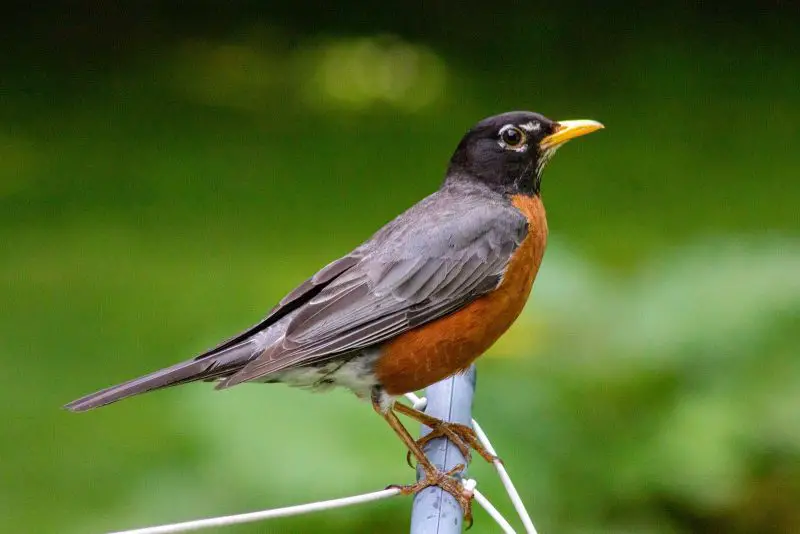
The American Robin is one of the most familiar birds in Indiana yards, especially in the spring and summer months. They have a distinctive orange-red breast contrasted by a gray-brown back and head. Adult robins measure about 9 to 11 inches long with a round body and long legs, making them easy to spot as they hop across lawns. Their bright yellow beaks and white eye rings are helpful identification markers.
Robins are active foragers on the ground, primarily searching for earthworms and insects, which make up most of their diet in warmer months. They can often be seen pulling worms from the soil or flipping over leaves in search of beetles and other invertebrates. In the fall and winter, robins switch to eating berries and fruits, such as those from holly or crabapple trees. Their cheerful, melodic song is a classic sign of spring in Indiana.
Robins prefer open woodlands, gardens, and lawns, thriving in suburban and urban settings. In Indiana, they are migratory, with many leaving during the coldest winter months, but some overwinter where food is available. Their adaptability to different habitats and willingness to visit backyard feeders make them one of the most beloved birds in the state.
Blue Jay
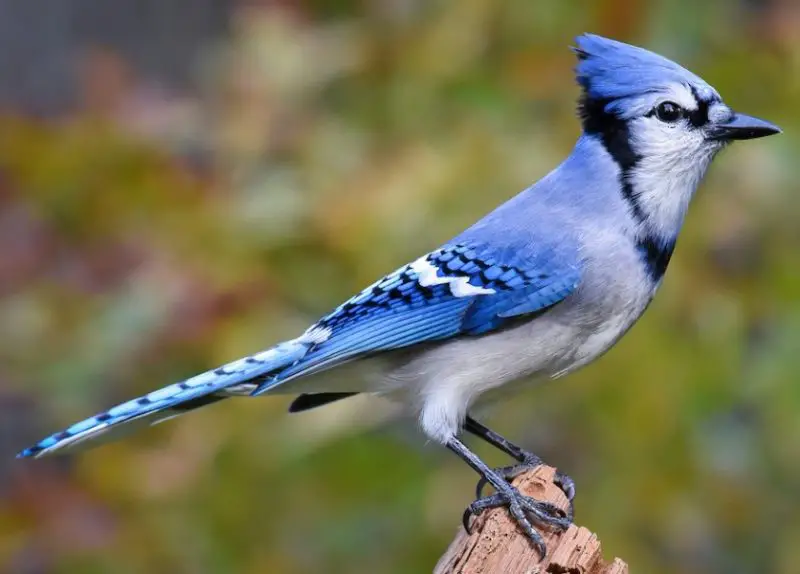
Blue Jays are large, vibrant birds known for their beautiful blue feathers, white chest, and striking black markings around their neck and face. Adult Blue Jays measure about 9 to 12 inches in length, with a prominent crest on the head that they raise when alarmed or excited. Their loud, varied calls—often described as harsh or “jay-jay” sounds—make them easily recognizable even before they are seen.
These birds are highly intelligent and social, often found in small family groups or mixed-species flocks. Blue Jays are bold visitors at backyard feeders, particularly fond of peanuts (in or out of the shell), sunflower seeds, and corn. They are also known for caching food, hiding seeds or nuts to eat later. Their behavior includes mimicking hawk calls to scare off other birds and sometimes engaging in playful antics.
Blue Jays are permanent residents throughout Indiana, commonly inhabiting deciduous and mixed forests, woodlots, and suburban areas. They are adaptable and often thrive close to human habitations. Their loud presence and striking colors make them favorites among bird enthusiasts, who enjoy watching their energetic and sometimes mischievous behavior at feeders.
Mourning Dove
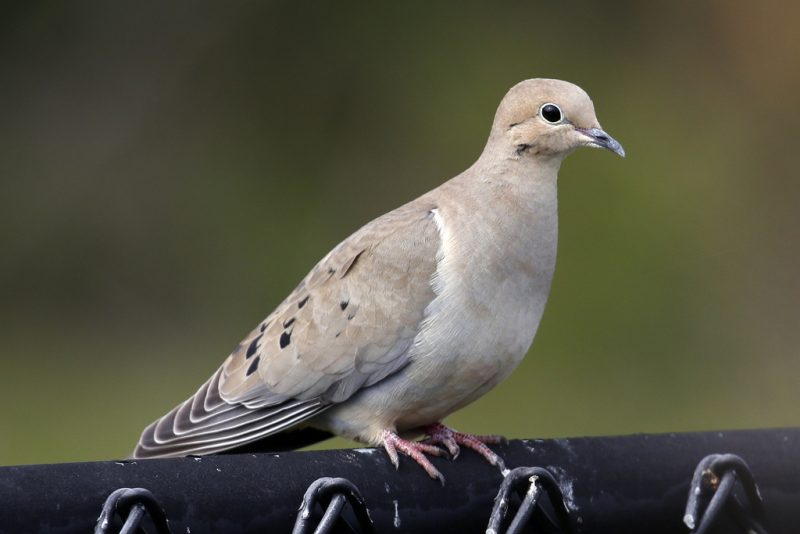
The Mourning Dove is a slender, graceful bird with soft gray-brown plumage and subtle black spots on the wings. Measuring about 9 to 13 inches in length, it has a long, pointed tail with white edges that is often seen fluttering gently as it flies. Their gentle cooing calls are a familiar sound in Indiana’s backyards and rural areas, evoking a calm and peaceful ambiance.
Mourning Doves are ground feeders, primarily eating small seeds such as millet, sunflower seeds, and cracked corn. They often forage on open ground or under feeders, picking up seeds scattered by other birds. These doves prefer open and semi-open habitats, including fields, parks, and residential yards. Their flight is swift and direct, marked by rapid wingbeats and occasional gliding.
In Indiana, Mourning Doves are year-round residents and are one of the most abundant and widespread birds. They adapt well to suburban environments and are frequent visitors to backyard feeders, especially those stocked with seeds suitable for ground feeding. Their gentle presence and soft calls make them a welcome sight in many gardens and open spaces across the state.
House Sparrow
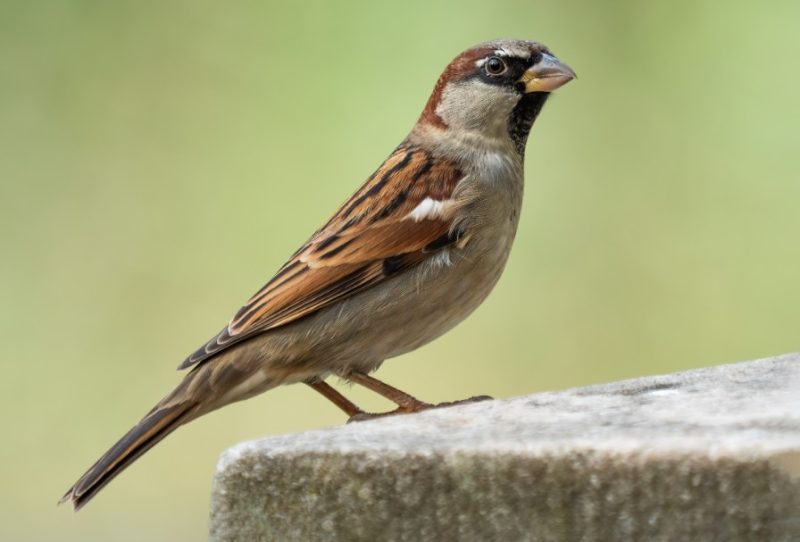
House Sparrows are small, stout birds with chunky bodies measuring around 6 to 7 inches long. Males have a distinctive gray crown, black bib, and chestnut markings on their wings and back, while females and juveniles have a more uniform brown and gray streaked plumage that provides excellent camouflage. Although not native to North America, House Sparrows have become widespread and common across Indiana.
These sparrows are highly adaptable and thrive in urban and suburban environments, often nesting in eaves, vents, and crevices of buildings. They are frequent visitors to backyard feeders, consuming a wide variety of seeds, grains, and scraps. House Sparrows are social and often found in flocks, sometimes competing aggressively with native birds for food and nesting sites.
In Indiana, House Sparrows are year-round residents, commonly seen around homes, parks, and farms. Their close association with human habitats has allowed them to spread rapidly and establish dense populations. While some birders view them as invasive, their persistent and energetic behavior adds a dynamic presence to many backyards throughout the state.
Black-capped Chickadee
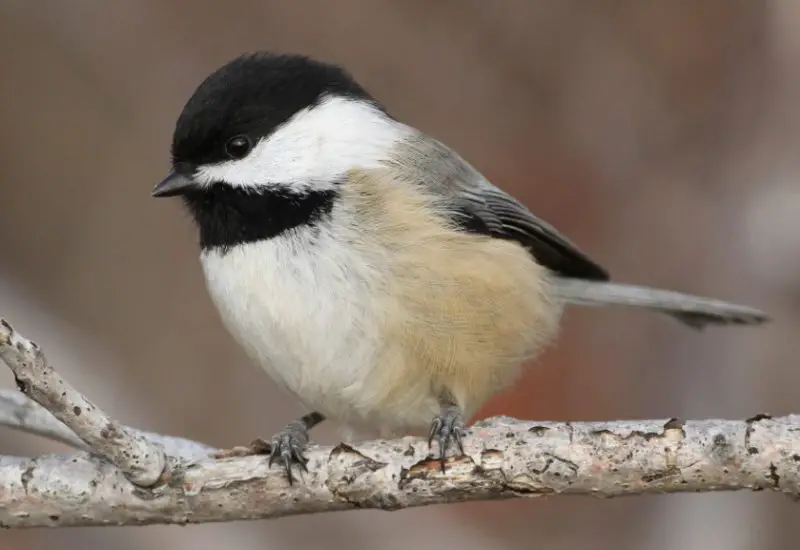
The Black-capped Chickadee is a small, plump songbird easily recognized by its black cap and bib, contrasted with bright white cheeks and a soft gray back. Measuring around 4.5 to 5 inches in length, this tiny bird has a short neck and large head that give it a charming appearance. Its wings and tail are edged with subtle white markings, making it stand out in winter and summer alike.
These chickadees are very friendly and curious, often approaching feeders and people in search of seeds and suet. They have a distinctive “chick-a-dee-dee-dee” call that varies in intensity depending on mood or alertness to danger. Their behavior includes hanging upside down on branches or feeders while they search for food, demonstrating agility and boldness uncommon for such small birds.
Black-capped Chickadees are common year-round residents in Indiana, thriving in mixed woodlands, suburban yards, and parks. They prefer areas with plenty of trees and shrubs where they can nest in tree cavities or nest boxes. These birds are adaptable and highly social, often forming mixed flocks with other small birds during the colder months.
Downy Woodpecker
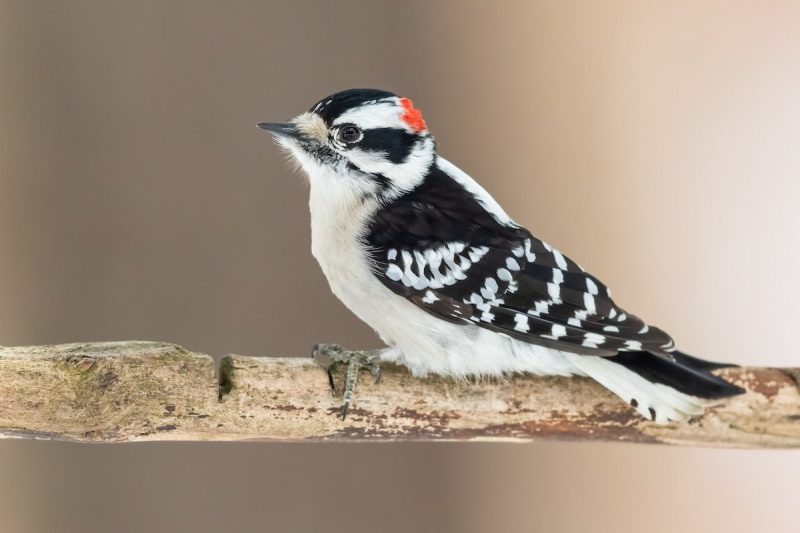
The Downy Woodpecker is the smallest woodpecker species in North America, measuring about 5.5 to 6 inches long. It has black and white plumage with a white belly and black wings spotted with white. Males feature a small red patch on the back of their heads, while females lack this marking. Its short, chisel-like bill is perfectly adapted for tapping on thin tree bark and probing for insects.
These woodpeckers are frequently seen drumming on trees, wooden structures, or even metal gutters, creating their characteristic tapping sound. They feed mainly on insects and larvae found under bark, but also visit feeders for suet, sunflower seeds, and peanuts. Their nimble movements allow them to cling to tree trunks and branches as they forage.
Downy Woodpeckers are common across Indiana throughout the year, inhabiting forests, parks, and suburban woodlots. They readily visit backyard feeders, especially in winter, and are important contributors to controlling insect populations in their habitats. Their small size and distinctive markings make them a favorite for birdwatchers.
Tufted Titmouse
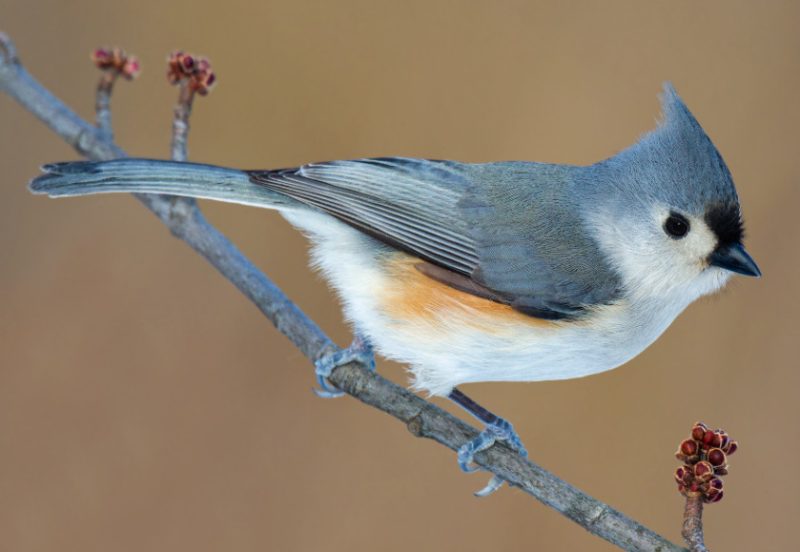
The Tufted Titmouse is a medium-small songbird measuring about 5.5 to 6 inches in length. It is easily recognized by its soft gray body, white underparts, and a distinctive pointed crest on its head. The bird also has subtle rust-colored flanks and large, dark eyes that give it an alert expression. Their vocalizations include a clear, whistled “peter-peter-peter” call that is common in Indiana woodlands.
Tufted Titmice are active and inquisitive birds, often seen hopping energetically through branches or visiting feeders. They feed on insects, seeds, nuts, and berries, and are especially fond of sunflower seeds and suet at feeders. Their behavior includes caching food to eat later and working in small flocks or mixed-species groups during the colder months.
These birds are year-round residents in Indiana, favoring deciduous and mixed forests as well as wooded suburban areas. They nest in tree cavities or nest boxes and are frequently attracted to backyard feeders, where their lively antics bring enjoyment to birdwatchers. Their soft gray color and crested head make them easy to spot among the trees.
Red-bellied Woodpecker
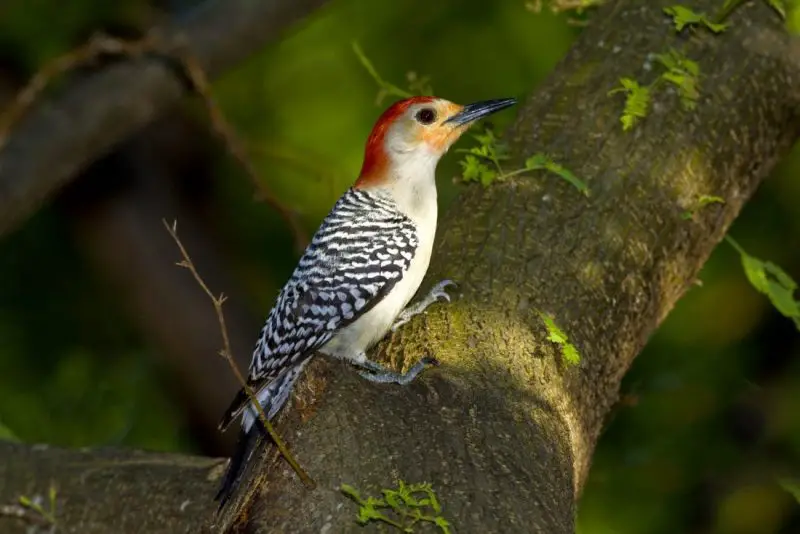
The Red-bellied Woodpecker is a medium-sized woodpecker, about 9 to 10 inches long, with a striking red cap extending from the bill to the nape in males, while females have red only on the back of the head. Despite its name, the reddish tint on the belly is often faint and hard to see. Its back is barred black and white, providing excellent camouflage on tree trunks.
These woodpeckers forage by climbing tree trunks and branches, probing crevices for insects, and sometimes eating fruits and nuts. They are frequent visitors to backyard feeders, especially those offering suet, peanuts, and sunflower seeds. Known for their loud “churr” call and drumming behavior, Red-bellied Woodpeckers are bold and territorial.
In Indiana, Red-bellied Woodpeckers are permanent residents, commonly found in deciduous forests, woodlots, and suburban areas with mature trees. They nest in tree cavities and readily accept nest boxes. Their striking red markings and energetic presence make them a favorite sight at feeders across the state.
Carolina Wren
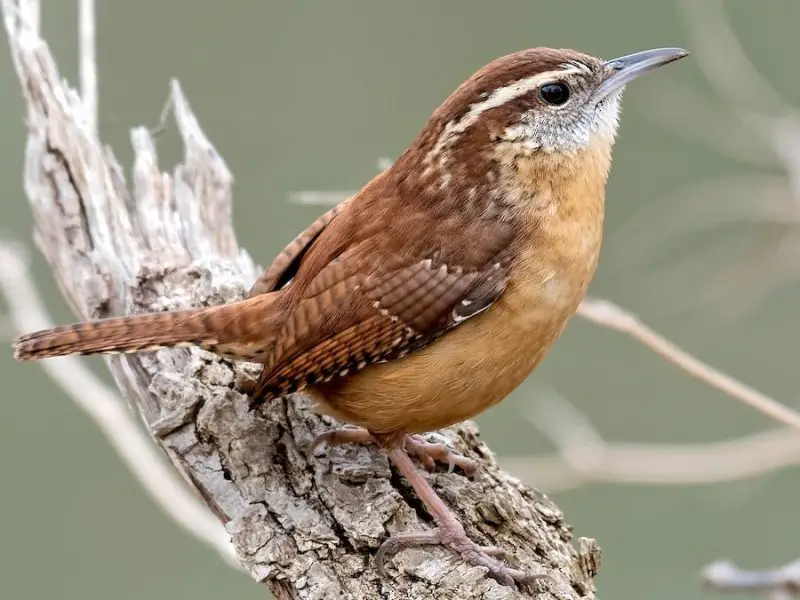
The Carolina Wren is a small, active bird measuring about 4 to 5 inches long, with rich reddish-brown upperparts and warm buff underparts. It is distinguished by a bold white eyebrow stripe that contrasts with its dark eyes and slender, slightly curved bill. Known for its loud and melodious song, the Carolina Wren often sings from hidden perches in shrubs or thickets.
Wrens are insectivores, feeding primarily on insects and spiders, which they find by probing bark, leaves, and crevices. They are highly energetic and agile, often hopping through dense undergrowth or flitting quickly among branches. Although not frequent visitors to feeders, they occasionally take mealworms or suet in winter.
Carolina Wrens are primarily residents in southern Indiana but have been gradually expanding northward. They favor dense brushy habitats, woodland edges, and suburban gardens with thick shrubs. Their loud, persistent songs and lively behavior make them a delightful addition to many Indiana backyards, especially in warmer months.
European Starling
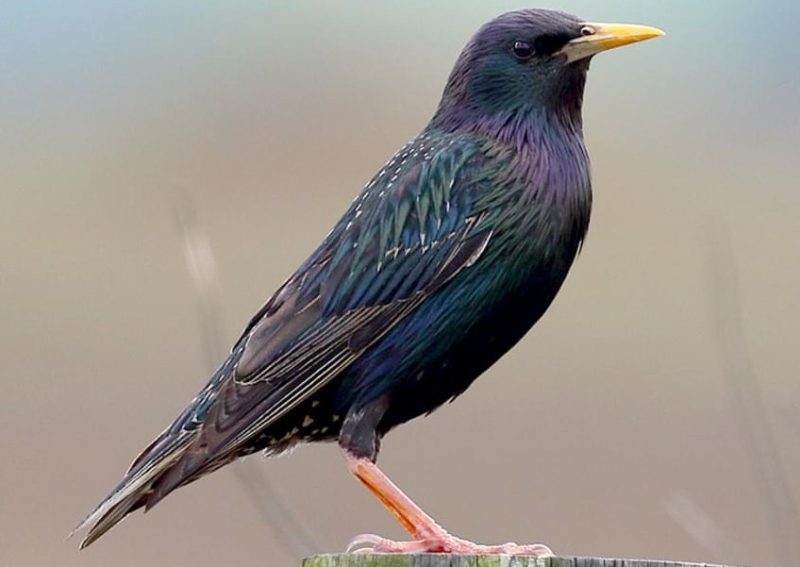
European Starlings are medium-sized birds known for their glossy black feathers that shimmer with iridescent greens and purples in sunlight. They have short tails, sharp pointed beaks, and a somewhat stocky build. These birds often gather in large, noisy flocks, creating spectacular murmurations in the sky that can include thousands of individuals.
Originally introduced from Europe, Starlings are not native to North America but have become one of the most common urban birds in Indiana and beyond. Their adaptability to city environments, parks, and agricultural areas has allowed them to thrive. They feed on a variety of insects, fruits, and seeds, often foraging on lawns and fields.
In Indiana, European Starlings are year-round residents and frequent visitors to backyard feeders. Their aggressive behavior sometimes displaces native birds from nesting sites and feeders, but their striking glossy plumage and gregarious nature make them an unmistakable part of the local bird community.
Eastern Bluebird
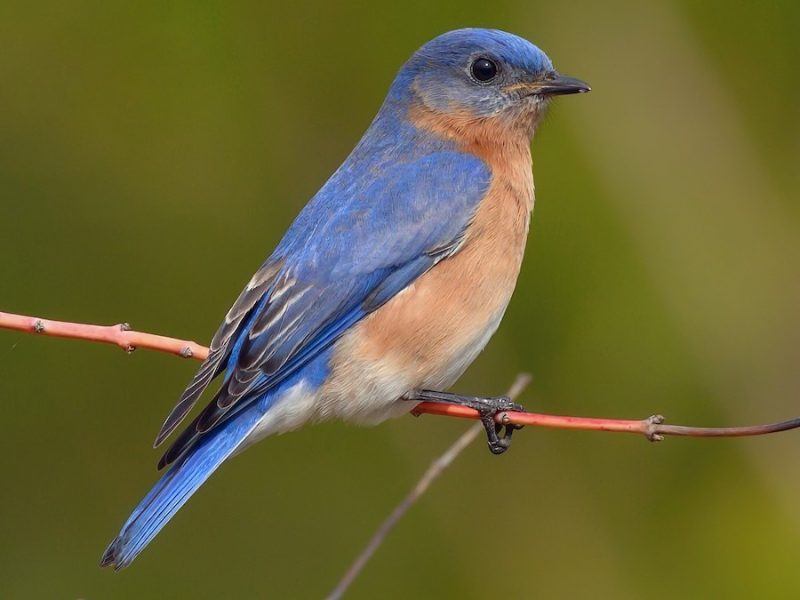
The Eastern Bluebird is a small, charming bird with bright blue upperparts and a warm orange chest and throat. Measuring about 6.5 to 7 inches in length, these birds have a slender body and a short tail. Males display the brightest blue coloration, while females are paler with more grayish tones on their backs.
Bluebirds prefer open habitats such as meadows, orchards, and residential yards with scattered trees. They commonly nest in cavities, often utilizing nest boxes provided by bird enthusiasts. Their diet consists mainly of insects and berries, which they hunt from perches or catch in flight.
In Indiana, Eastern Bluebirds are mostly present during spring and summer breeding seasons. Their population has benefited greatly from conservation efforts involving nest boxes. Bluebirds add vibrant color and cheerful activity to Indiana’s open spaces and suburban yards during warmer months.
White-breasted Nuthatch
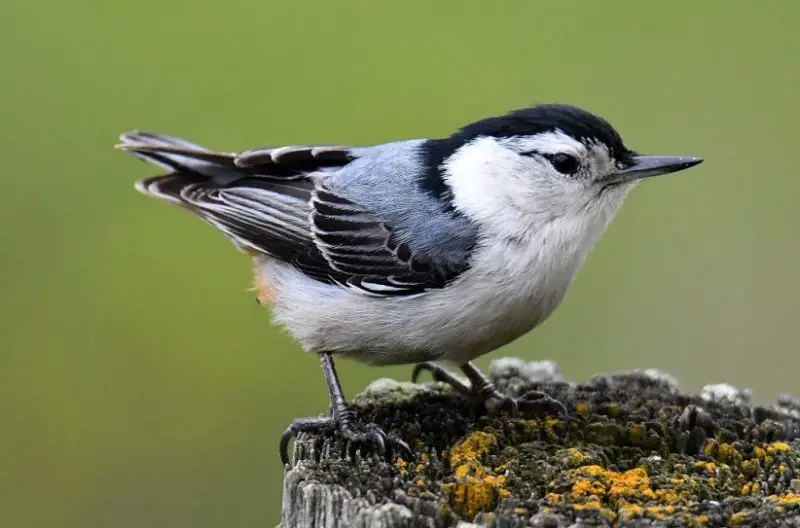
The White-breasted Nuthatch is a small bird about 5 to 6 inches long, easily identified by its clean white face and underparts contrasted with a slate-gray back and a black cap. It has a slightly upturned bill which it uses to probe bark for insects.
These nuthatches are famous for their unique behavior of climbing down tree trunks headfirst, unlike most birds which move upward. They forage on large tree branches and trunks, searching for insects, seeds, and nuts. They are also known to wedge food into bark crevices and hammer it open with their bills.
White-breasted Nuthatches are permanent residents in Indiana woodlands, parks, and mature suburban areas. They readily visit backyard feeders stocked with sunflower seeds and suet. Their bold, nasal calls and acrobatic foraging make them a favorite among bird watchers.
House Finch
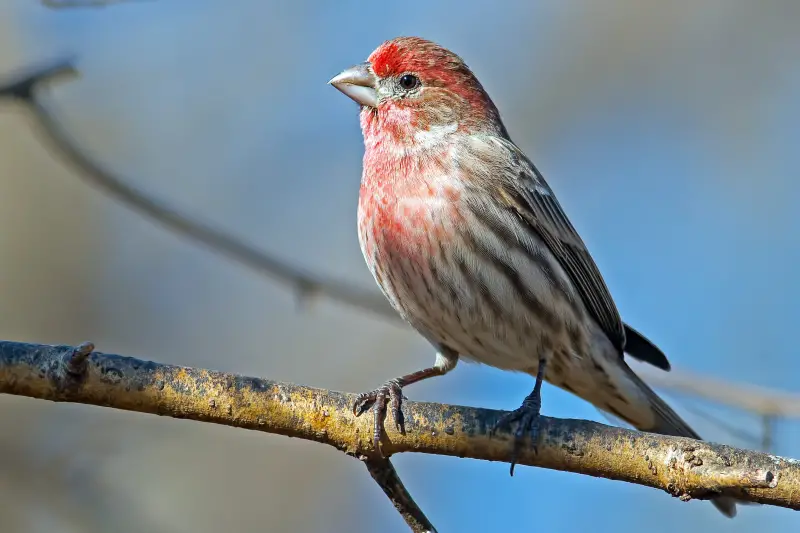
House Finches are small, sparrow-like birds measuring about 5 inches long. Males typically have bright red plumage on the head and chest, with streaked brown wings and backs. Females lack the red coloring and are generally brown and gray with streaks, making them less conspicuous.
These finches are highly adaptable and thrive in urban and suburban environments, frequently visiting backyard feeders to eat seeds and grains. They build nests in a variety of locations including trees, shrubs, and building ledges. Their cheerful warbling songs are commonly heard in residential areas.
House Finches are year-round residents throughout Indiana. Their ability to coexist closely with humans and utilize diverse nesting sites has helped them flourish. Their colorful males and lively presence make them a popular backyard bird.
Common Grackle
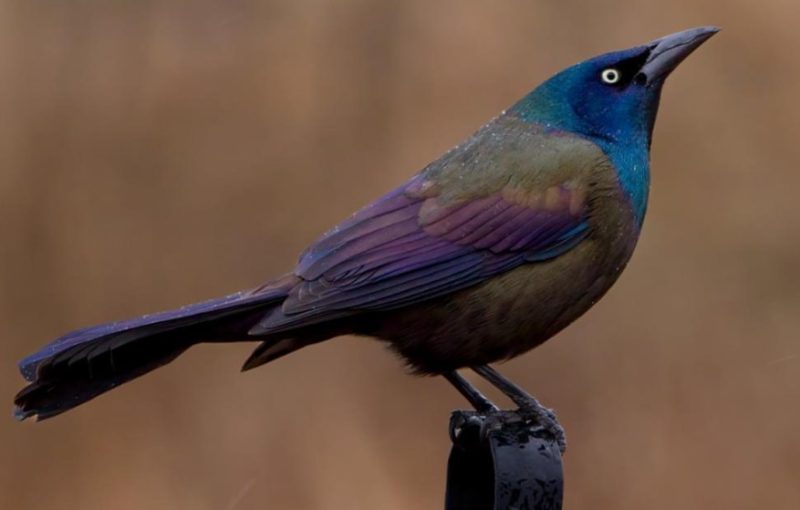
The Common Grackle is a large, striking blackbird with glossy black plumage that shines with iridescent blue, green, and purple hues in the sunlight. Adult males are especially glossy and have long tails that they often fan out in displays. These birds are known for their loud, harsh calls and bold behavior.
Grackles are highly adaptable and can be found in urban, suburban, and rural environments across Indiana. They nest in colonies, often choosing tall trees or shrubs near water or open fields. Their diet is varied, including insects, seeds, small fish, and even garbage from urban areas, making them opportunistic feeders.
Year-round residents in Indiana, Common Grackles often gather in large flocks, especially outside the breeding season. Their noisy presence and iridescent plumage make them a memorable part of many backyards, parks, and agricultural landscapes throughout the state.
Red-winged Blackbird
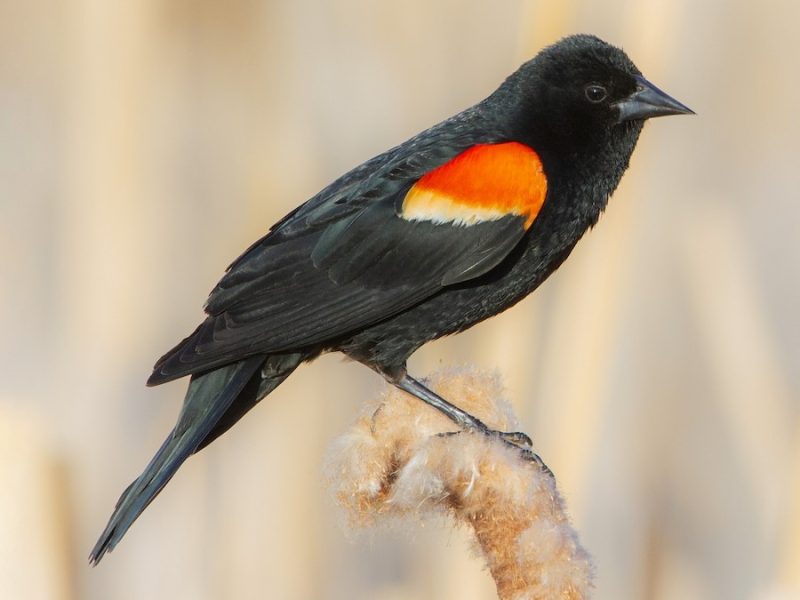
The Red-winged Blackbird is easily recognized by the male’s shiny black body and a bright red patch edged with yellow on each shoulder. Females are streaked brown and heavily camouflaged, resembling large sparrows. Males measure around 7 to 9 inches long, with a sharp, pointed bill used for catching insects and seeds.
This species favors wetlands, marshes, and agricultural fields, often nesting in dense cattails or reed beds. Males are highly territorial during the breeding season, displaying their red shoulder patches while singing their distinctive “conk-la-ree” calls to defend nesting areas.
In Indiana, Red-winged Blackbirds are common year-round, particularly abundant in spring and summer near ponds, marshes, and wet meadows. Their loud, musical calls and striking red wing patches are iconic sounds and sights of Indiana’s wetland habitats.
Song Sparrow
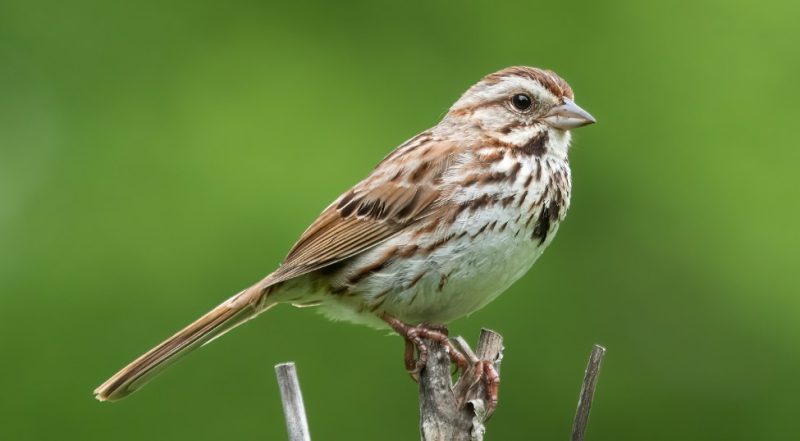
The Song Sparrow is a small, plump bird with brown and gray streaked plumage and bold dark streaks on its white chest, often forming a central spot. It measures about 5 to 6 inches long and has a rounded tail and a fairly large head. Their song is a complex and melodious series of trills and whistles that vary regionally.
Song Sparrows inhabit a variety of habitats, including dense shrubs, fields, gardens, and woodland edges. They forage on the ground or in low vegetation for seeds, insects, and small invertebrates. Their adaptable diet and habitat preferences allow them to thrive in suburban yards and natural areas alike.
In Indiana, Song Sparrows are widespread and often year-round residents. They are commonly heard singing in early spring, marking their territories with lively and varied songs that add musical charm to many backyards and natural spaces.
Eastern Towhee
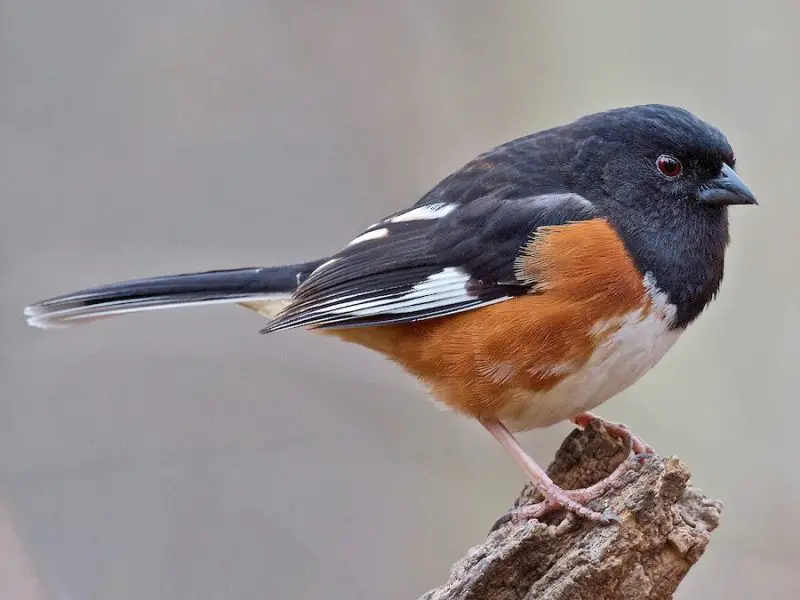
The Eastern Towhee is a medium-sized sparrow notable for its bold black, white, and rusty-orange coloration. Males have glossy black heads, backs, and wings, contrasted with bright white bellies and rich rusty flanks. Females are similar but have brown instead of black. These birds measure about 7 to 8 inches in length.
Towhees prefer dense shrubs, thickets, and forest edges where they forage by scratching leaf litter with both feet to uncover insects, seeds, and berries. They often produce a distinctive “drink-your-tea” song that echoes through woodlands and brushy areas.
In Indiana, Eastern Towhees are common residents and frequent visitors to suburban gardens and woodland edges. Their striking coloration and energetic behavior make them a favorite among birders, especially when they vocalize from thick cover.
Carolina Chickadee
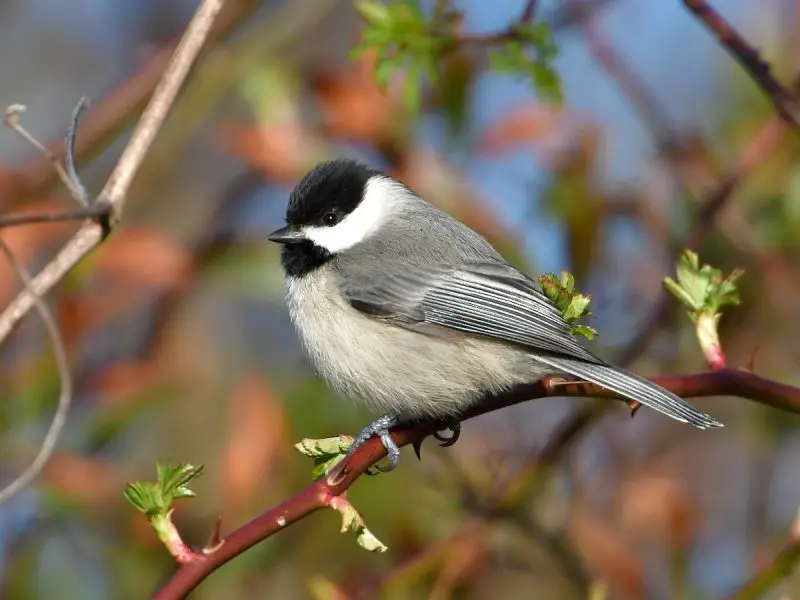
The Carolina Chickadee closely resembles the Black-capped Chickadee but can be distinguished by its slightly whiter cheeks and less extensive black cap. It is a small bird about 4.5 to 5 inches long, with soft gray upperparts and white underparts. Their calls are high-pitched and clear, often given in rapid sequences.
This species is highly adaptable, inhabiting deciduous forests, woodlands, and suburban areas with plenty of shrubs and trees. Carolina Chickadees forage actively for insects, seeds, and suet, frequently visiting backyard feeders throughout the year.
In Indiana, Carolina Chickadees are generally found in the southern part of the state, overlapping with Black-capped Chickadees in some areas. Their friendly nature and distinctive calls make them a delightful backyard visitor for many Indiana birdwatchers.
Mourning Dove
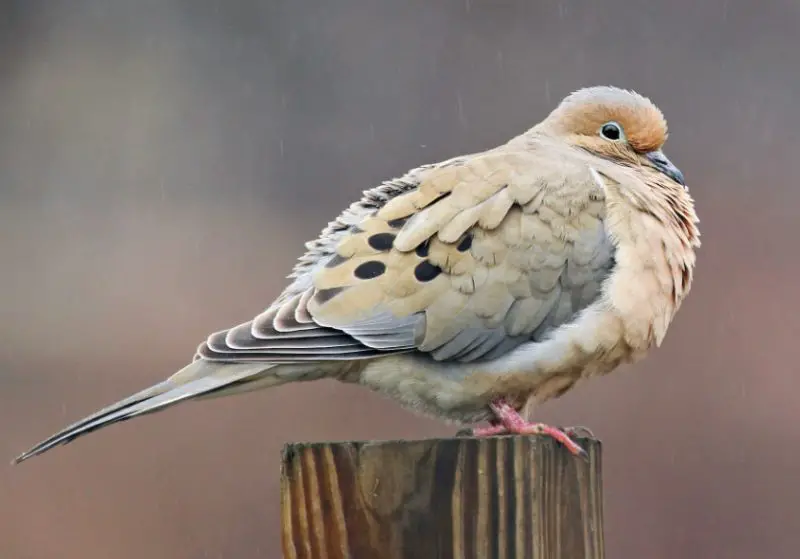
The Mourning Dove is a slender, graceful bird with light brown plumage and subtle black spots on its wings. Measuring about 9 to 13 inches long, it has a long, pointed tail with white edges visible during flight. Their soft, mournful cooing calls are familiar sounds in Indiana’s backyards and rural areas, creating a calm and peaceful atmosphere.
Mourning Doves often perch quietly on power lines, fence posts, or tree branches, and they forage mostly on the ground for seeds such as millet, sunflower, and cracked corn. They are fast, direct flyers with rapid wingbeats and occasional glides, making them easily noticeable when taking off or landing.
These birds are year-round residents in Indiana, thriving in open and semi-open habitats like fields, parks, and suburban yards. Their gentle demeanor and soft calls make them a welcome presence in many gardens and open spaces across the state.
Eastern Phoebe
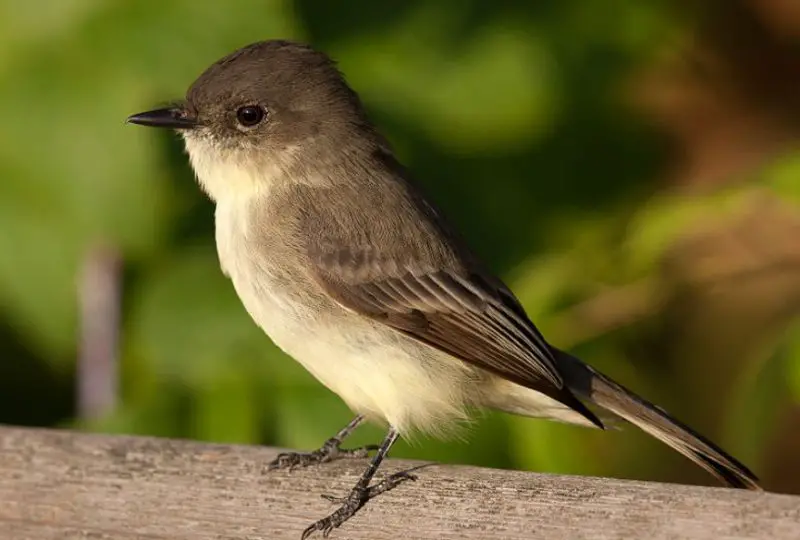
The Eastern Phoebe is a small songbird, roughly 6 to 7 inches in length, with plain gray-brown upperparts and pale, off-white underparts. One distinctive behavior is its characteristic tail wag or bob, often seen as it perches near water or low shrubs. Its song is a sharp, clear “fee-bee” that resonates through wooded and riparian areas.
Eastern Phoebes typically nest on ledges, bridges, or buildings, preferring sheltered spots near streams, ponds, or open woodlands. They catch insects mid-air or glean them from surfaces, playing an important role in controlling insect populations. Their active hunting style involves short flights from perches followed by quick returns.
In Indiana, Eastern Phoebes are common spring and summer residents, often one of the first migratory birds to arrive in early spring. They frequent backyards, parks, and forest edges, making them a delightful sight and sound in many natural and suburban settings.
Yellow-bellied Sapsucker
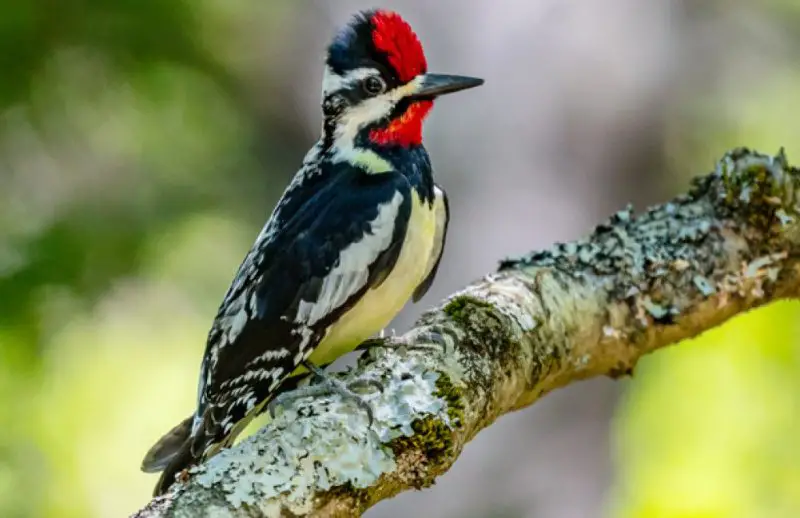
The Yellow-bellied Sapsucker is a medium-sized woodpecker about 7 to 8 inches long, with a striking red crown and throat patch, yellowish belly, and black-and-white barred wings and back. Males typically have a red throat, while females have a white throat. This species is known for drilling neat rows of holes in tree bark to feed on sap and insects.
These woodpeckers inhabit mixed forests, often near wetlands or wooded swamps, where they forage by pecking on trees and sometimes visiting sap wells created by themselves or other birds. Their distinctive drumming and tapping are often heard echoing through Indiana’s woodlands.
Yellow-bellied Sapsuckers are migratory, arriving in Indiana primarily during spring and fall migration periods. Their unique feeding habits and bold red head make them an interesting and colorful presence in forested areas during their visits.
Belted Kingfisher
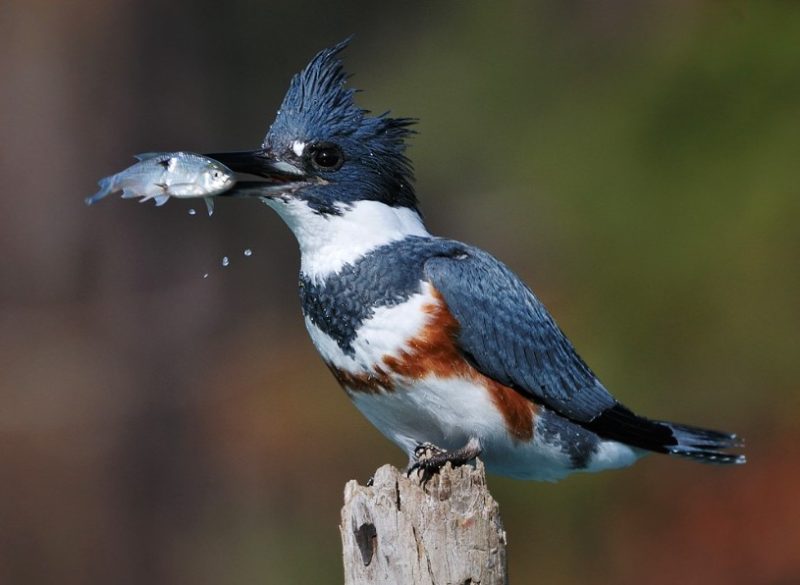
The Belted Kingfisher is a large, stocky bird around 11 to 14 inches long, notable for its shaggy crest and sturdy, pointed bill. Its blue-gray upperparts contrast sharply with a white collar and belly, while females often have a rusty band across their chest in addition to the blue belt found in both sexes.
These birds are commonly found near rivers, lakes, ponds, and wetlands where they hunt by hovering or perching above water before diving headfirst to catch fish. Belted Kingfishers also eat aquatic insects and small amphibians. Their rattling calls are loud and unmistakable along Indiana’s waterways.
Belted Kingfishers are year-round residents in southern Indiana and migratory visitors in northern parts of the state. Their association with water and impressive fishing dives make them a favorite bird for nature watchers and anglers alike.
Chimney Swift
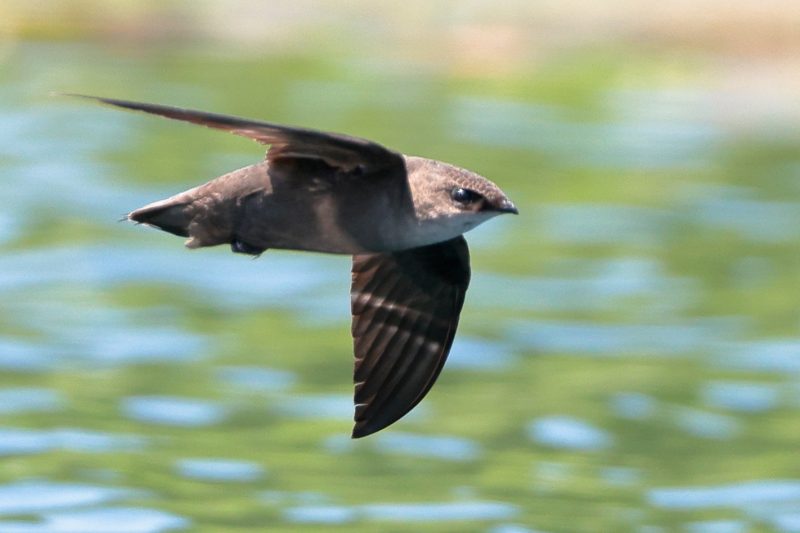
Chimney Swifts are small, cigar-shaped birds about 5 inches long, with dark gray plumage and long, narrow wings that give them a distinctive silhouette in flight. They are almost never seen perched except when nesting, instead spending most of their time flying rapidly and gracefully, catching insects on the wing.
These swifts typically nest in chimneys, old buildings, and other vertical structures, attaching their nests made of twigs and saliva to vertical surfaces. Their aerial acrobatics and constant motion make them a fascinating sight in summer skies.
In Indiana, Chimney Swifts are migratory, arriving in late spring and leaving by early fall. They thrive in urban and suburban areas with available nesting sites and are often seen circling high above towns and cities at dusk before roosting.
Eastern Wood-Pewee
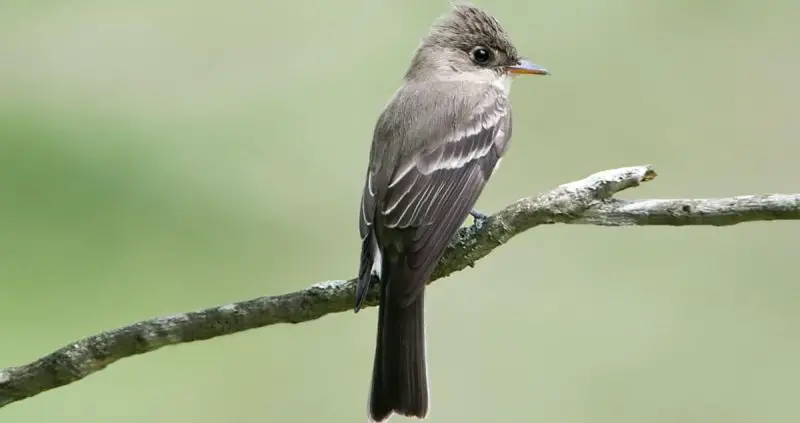
The Eastern Wood-Pewee is a small, slender flycatcher measuring about 6 to 7 inches in length, with a plain grayish-olive upper body and lighter underparts. Its subtle coloration helps it blend into the open woodlands and forest edges where it typically resides. The bird is best known for its plaintive, whistled “pee-a-wee” song that echoes softly through Indiana’s forests during summer.
Eastern Wood-Pewees are insectivores, catching flies and other small flying insects mid-air with quick, agile sallies from perches. They prefer open forested areas and woodland edges where they perch quietly before darting out to snatch prey. Their behavior is somewhat reserved, often remaining still for long periods.
In Indiana, Eastern Wood-Pewees are migratory breeders, arriving in late spring and leaving in early fall. They favor mature deciduous forests and mixed woodlands, contributing to the rich bird diversity in Indiana’s forested habitats during the warmer months.
White-crowned Sparrow
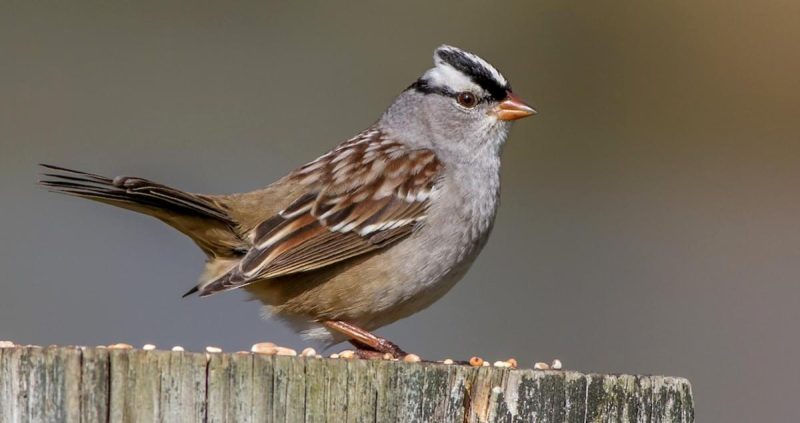
The White-crowned Sparrow is a small songbird about 6 to 7 inches long, notable for its striking black and white stripes across the crown of its head. Its gray face and underparts contrast with brown streaked wings and back. These sparrows are often seen during winter in open fields, meadows, and suburban yards.
White-crowned Sparrows forage mainly on the ground, feeding on seeds and insects. They are known for their clear, whistled songs and calls, which vary geographically. During winter in Indiana, they gather in flocks and frequent bird feeders, adding lively activity to backyard birdwatching.
These sparrows are migratory, spending summers breeding in northern regions and arriving in Indiana during the colder months. Their distinctive head stripes and melodic whistles make them easy to identify and welcome visitors during Indiana’s winter season.
Red-headed Woodpecker
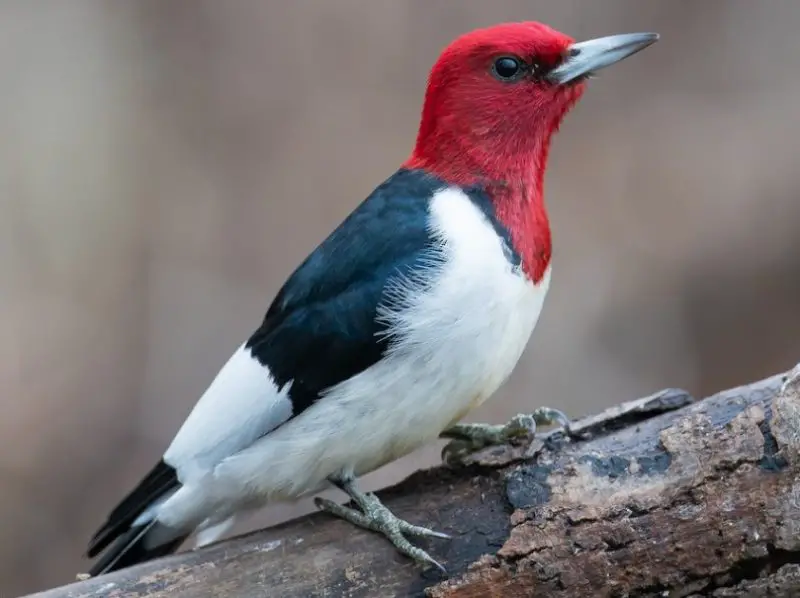
The Red-headed Woodpecker is a medium-sized, boldly colored bird measuring about 8 to 9 inches in length. It stands out with a completely bright red head and neck, contrasting sharply with its white body and black wings with white patches. This striking coloration makes it one of the most eye-catching woodpeckers in Indiana.
These woodpeckers forage on tree trunks, branches, and open ground, feeding on insects, nuts, fruits, and sometimes small vertebrates. They are also known to cache food in tree crevices or under bark. Red-headed Woodpeckers nest in tree cavities, often in dead or dying trees, preferring mature forests and large parks.
In Indiana, Red-headed Woodpeckers are permanent residents, though their numbers have declined in some areas due to habitat loss. They favor open woodlands, orchards, and suburban parks, where their vivid colors and energetic behavior attract attention from birdwatchers.
House Wren
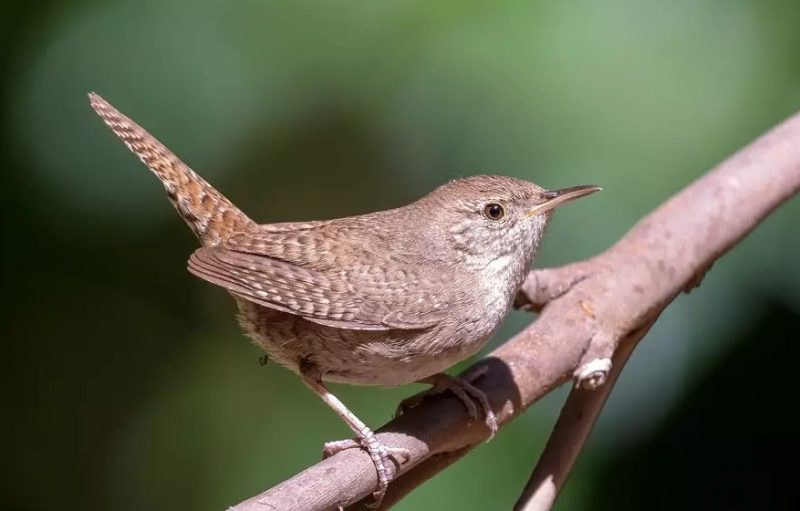
The House Wren is a small, energetic bird about 4 to 5 inches long, with warm brown plumage streaked subtly with darker markings. Its plain coloring is offset by a bubbly, cheerful song that fills Indiana’s gardens and woodlands during spring and summer.
Wrens are cavity nesters, often using natural holes, crevices, or nest boxes for raising their young. They forage actively for insects and spiders, frequently searching through dense brush and leaf litter. Their behavior includes rapid wing flicks and constant movement as they explore their environment.
House Wrens are widespread breeders in Indiana, commonly found in suburban yards, parks, and forest edges. Their joyful songs and lively antics make them a favorite among backyard bird enthusiasts during the warmer months.
Gray Catbird
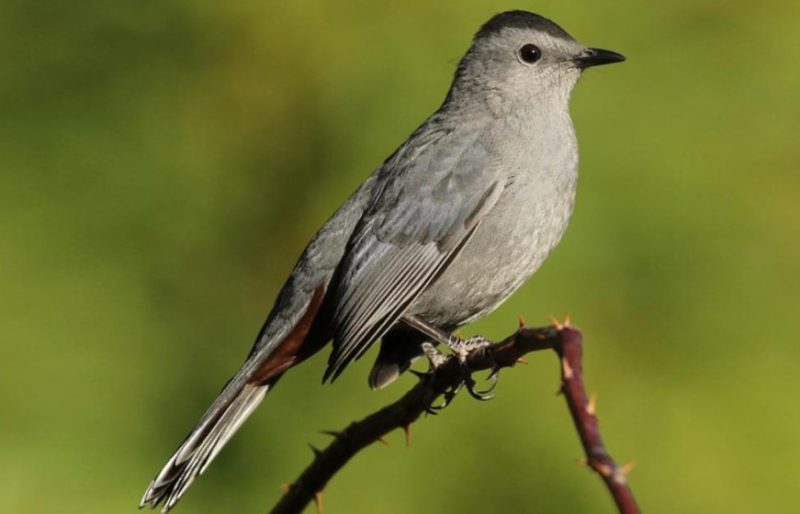
The Gray Catbird is a medium-sized songbird about 8 to 9 inches long, with soft gray plumage, a distinctive black cap, and rusty-red undertail coverts. It is named for its cat-like “mew” call, which is just one of its many varied vocalizations.
Catbirds prefer dense shrubs, thickets, and woodland edges where they forage for insects, berries, and fruit. They are known for their mimicry, often incorporating sounds from other birds and environmental noises into their songs. Their secretive nature means they are often heard more than seen.
In Indiana, Gray Catbirds are common summer residents, frequently visiting suburban gardens and natural areas. Their rich vocal abilities and shy behavior add a fascinating dimension to backyard birdwatching throughout the breeding season.
Indigo Bunting
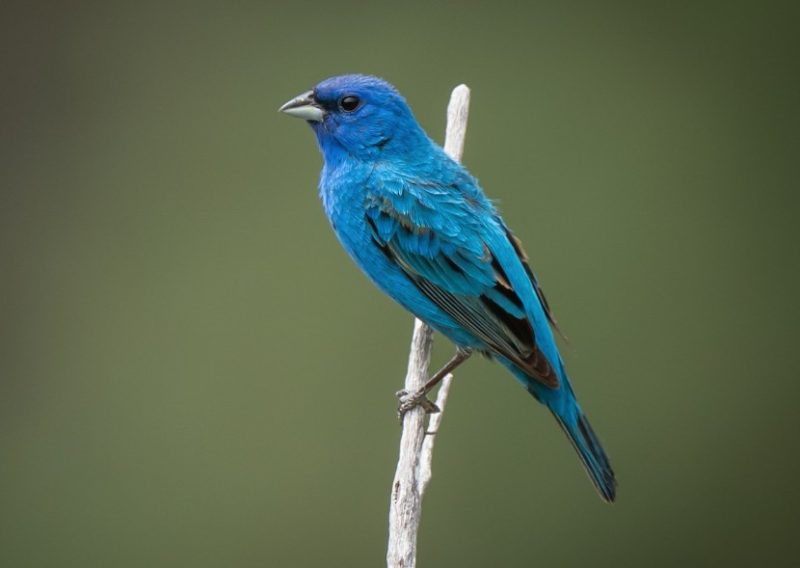
The male Indigo Bunting is a small songbird renowned for its brilliant cobalt blue plumage that shines vividly in sunlight. Females are more subdued, sporting a warm brown coloration that helps them blend into dense shrubs and grasslands. These birds measure around 4.5 to 5 inches long, with a short, conical bill suited for seed and insect feeding.
Indigo Buntings favor shrubby areas, woodland edges, and open fields where they forage primarily on seeds, berries, and insects. Males sing a bright, musical song from perches to establish territory and attract mates. Their striking blue color is most noticeable during the breeding season, while females remain more camouflaged for nesting.
In Indiana, Indigo Buntings are summer residents that arrive in late spring and depart by early fall. They are often seen in backyards with dense vegetation and open spaces, delighting bird watchers with their vivid hues and cheerful songs.
Killdeer
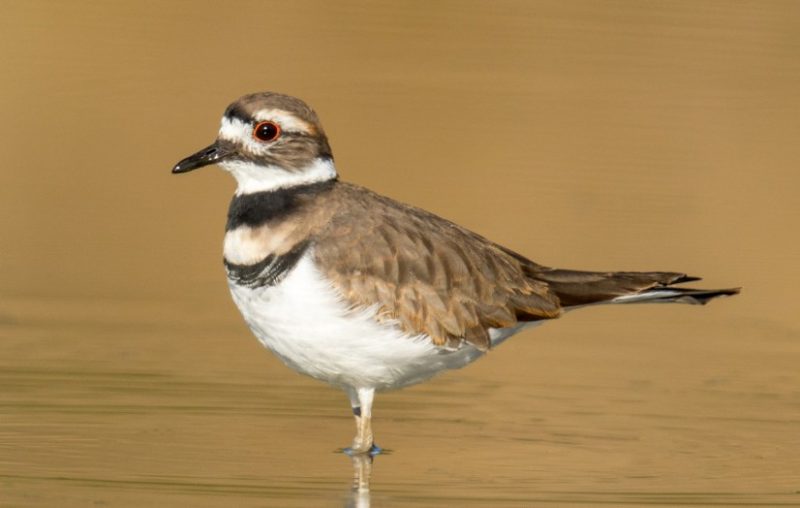
The Killdeer is a medium-sized plover measuring about 10 to 12 inches long, easily identified by its two distinctive black neck bands and a white belly. Its brown back and wings provide excellent camouflage in open, sandy, or grassy habitats. Killdeer have long legs and large eyes, adapted for spotting insects and small invertebrates on the ground.
These birds are commonly found in open areas such as golf courses, fields, gravel roads, and sandy riverbanks. Killdeer are famous for their “broken-wing” distraction display, where they feign injury to lure predators away from nests. Their loud, piercing calls are often heard in open landscapes, especially at dusk.
In Indiana, Killdeer are widespread and often nest on open bare ground. They are year-round residents in southern parts of the state and migratory visitors elsewhere. Their adaptability to disturbed habitats makes them familiar sights in both urban and rural settings.
Common Yellowthroat
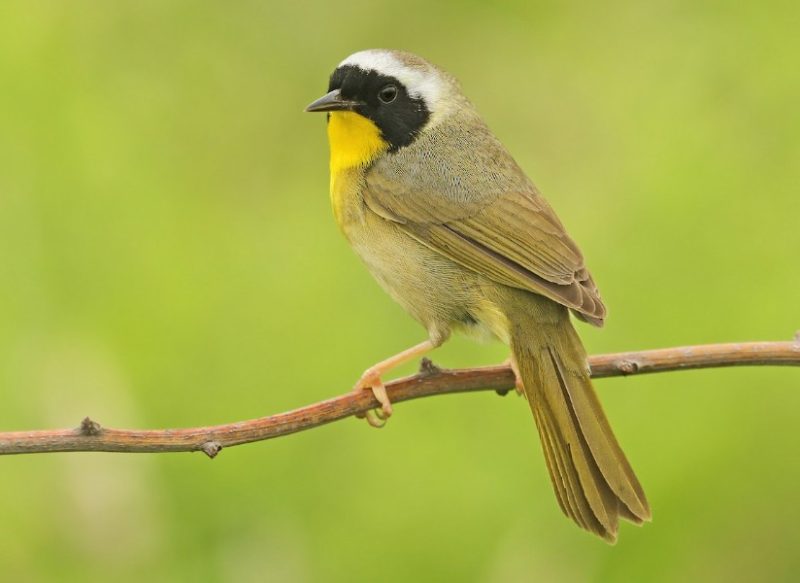
The Common Yellowthroat is a small, secretive warbler about 4.5 to 5 inches long, recognized by the male’s bold black mask bordered with white or gray. Its bright yellow throat and underparts contrast with olive-green upperparts. Females lack the black mask but retain the yellow throat and are slightly duller in color.
These birds inhabit dense marshes, wet meadows, and shrubby areas where they forage for insects, spiders, and other small invertebrates. Their distinctive “wichity-wichity-wichity” song is often heard but the bird itself can be hard to spot due to its preference for thick vegetation.
In Indiana, Common Yellowthroats are migratory summer residents, frequenting wetlands and dense brushy habitats. They add a splash of bright color and lively song to Indiana’s marshes and wet meadows during the breeding season.
Brown Thrasher
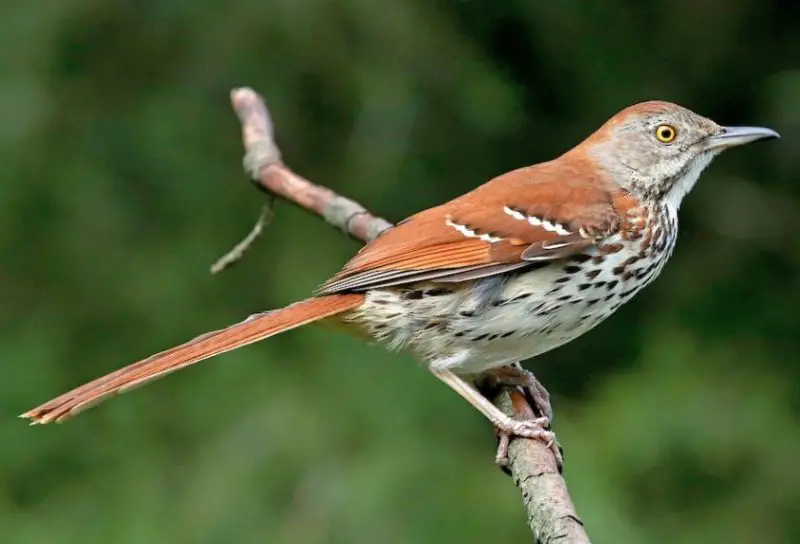
The Brown Thrasher is a medium-sized songbird measuring about 9 to 11 inches long, with warm brown upperparts heavily streaked with black and a buffy-white underbelly with streaks. It has bright yellow eyes and a long, curved bill ideal for foraging.
Thrashers are known for their rich and varied songs, often singing long sequences with many repeated phrases. They inhabit dense shrubs, forest edges, and overgrown gardens where they forage by sweeping leaf litter with their bills to uncover insects, berries, and seeds.
In Indiana, Brown Thrashers are common summer residents, often found in suburban gardens and natural thickets. Their vocal talents and secretive behavior make them a rewarding species for attentive bird watchers.
FAQ About Backyard Birds in Indiana
What Are Some Common Backyard Birds Found in Indiana?
Common backyard birds in Indiana include the Northern Cardinal, American Robin, Blue Jay, Mourning Dove, and House Sparrow. These species are frequently seen visiting feeders and nesting in suburban and rural areas throughout the state.
When Is the Best Time to Watch Backyard Birds in Indiana?
The best time for birdwatching in Indiana is during the spring and summer breeding seasons when many migratory birds arrive, and birds are actively feeding their young. Early mornings are typically the most active times for bird activity.
How Can I Attract More Birds to My Backyard?
To attract more birds, provide a variety of feeders with seeds like sunflower and millet, offer fresh water for drinking and bathing, and plant native shrubs and trees that provide natural food and shelter.
What Should I Feed Backyard Birds in Indiana?
Popular foods include black oil sunflower seeds, suet, peanuts, millet, and nyjer seeds. Different species have different preferences, so offering a variety ensures attracting a wider range of birds.
Are There Any Non-Native Birds in Indiana Backyards?
Yes, species like the House Sparrow and European Starling are non-native but common in Indiana backyards. While widespread, they can sometimes compete with native birds for nesting and feeding opportunities.
Do Backyard Birds in Indiana Change Seasonally?
Yes, some birds are year-round residents, while others are migratory and only present during breeding or winter seasons. For example, American Robins are common in summer, while White-crowned Sparrows typically appear in winter.
How Can I Help Support Backyard Birds Year-Round?
Providing food and water year-round, maintaining native plants, offering shelter like birdhouses or brush piles, and avoiding pesticides are all ways to support birds throughout the year.
Are Backyard Birds Beneficial for Gardens?
Absolutely. Many backyard birds consume large quantities of insects and pests, helping maintain a healthy garden ecosystem naturally.

